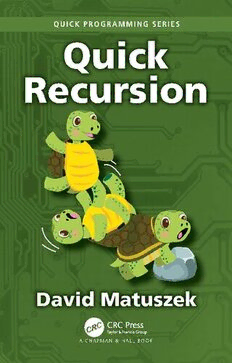Table Of ContentQuick Recursion
Recursion is the best tool for working with trees and graphs. But
perhaps you’ve studied recursion and decided it’s too complicated.
You just can’t think that way. That limits the kind of programming
you can do.
Good news! Recursion is actually easy. It’s just badly taught.
See, many instructors talk about how the computer does it. They go
on and on about what happens at each level of the recursion and
how each level relates to other levels. The problem is that you can’t
think in multiple levels. Nobody can. And you don’t have to.
This book will show you how you can write recursive programs.
Once you understand a few simple rules, you will wonder why
you ever thought recursion was complicated. You’ll be able to
write recursive programs quickly and easily.
Well, as quick and easy as programming ever is, anyway.
Quick Recursion
David Matuszek
First edition published 2023
by CRC Press
6000 Broken Sound Parkway NW, Suite 300, Boca Raton, FL 33487-2742
and by CRC Press
4 Park Square, Milton Park, Abingdon, Oxon, OX14 4RN
CRC Press is an imprint of Taylor & Francis Group, LLC
© 2023 David Matuszek
Reasonable efforts have been made to publish reliable data and information, but the author and
publisher cannot assume responsibility for the validity of all materials or the consequences of their
use. The authors and publishers have attempted to trace the copyright holders of all material
reproduced in this publication and apologize to copyright holders if permission to publish in this
form has not been obtained. If any copyright material has not been acknowledged please write and
let us know so we may rectify in any future reprint.
Except as permitted under U.S. Copyright Law, no part of this book may be reprinted,
reproduced, transmitted, or utilized in any form by any electronic, mechanical, or other means,
now known or hereafter invented, including photocopying, microfilming, and recording, or in
any information storage or retrieval system, without written permission from the publishers.
For permission to photocopy or use material electronically from this work, access www.copyright.
com or contact the Copyright Clearance Center, Inc. (CCC), 222 Rosewood Drive, Danvers, MA
01923, 978-750-8400. For works that are not available on CCC please contact
[email protected]
Trademark notice: Product or corporate names may be trademarks or registered trademarks
and are used only for identification and explanation without intent to infringe.
Library of Congress Cataloguing-in-Publication Data
Names: Matuszek, David L., author.
Title: Quick recursion / David Matuszek.
Description: First edition. | Boca Raton : Taylor and Francis, 2023. | Series: Quick
programming | Includes bibliographical references and index.
Identifiers: LCCN 2022041466 (print) | LCCN 2022041467 (ebook) | ISBN 9781032417585
(paperback) | ISBN 9781032417592 (hardback) | ISBN 9781003359616 (ebook)
Subjects: LCSH: Recursive programming. | Recursion theory.
Classification: LCC QA76.6 .M369 2023 (print) | LCC QA76.6 (ebook) | DDC 005.13/1--dc23/
eng/20221107
LC record available at https://lccn.loc.gov/2022041466
LC ebook record available at https://lccn.loc.gov/2022041467
ISBN: 978-1-032-41759-2 (hbk)
ISBN: 978-1-032-41758-5 (pbk)
ISBN: 978-1-003-35961-6 (ebk)
DOI: 10.1201/9781003359616
Typeset in Minion
by MPS Limited, Dehradun
To all my students
past, present, and future
Contents
Author,xi
Preface,xiii
Chapter 1 Understanding Recursion 1
■
1.1 A Note on Languages 1
1.2 Recursive Definitions 1
1.3 A Simple Recursive Procedure 5
1.4 Factorial 8
1.5 The Principle of Information Hiding 9
1.6 When to Use Recursion 15
1.7 When Not to Use Recursion 16
1.8 The Four Rules 16
1.8.1 Rule 1. Handle the Base Cases First 17
1.8.2 Rule 2. Recur Only with a Simpler
Case 17
1.8.2.1 An Aside: The Collatz
Conjecture 19
1.8.3 Rule 3. Don’t Use External Variables 20
1.8.3.1 Deep Copies 23
1.8.4 Rule 4. Don’t Look Down 25
vii
viii ▪ Contents
1.9 What the Computer Does 27
1.10 Removing Recursion 28
1.11 Tail Recursion 30
1.12 Recursive Drawings 31
1.13 Fortran and Lisp 33
Chapter 2 Data Structures 35
■
2.1 Arrays 35
2.1.1 Array Maximum 35
2.1.2 Quicksort 37
2.2 Lists 40
2.2.1 Lists in Java 41
2.2.2 Lists in Python 43
2.2.3 Accumulators 45
2.3 Binary Trees 46
2.3.1 Printing Binary Trees 50
2.3.2 Counting Nodes 51
2.4 Trees 53
2.4.1 Parse Trees 54
2.4.2 Indirect Recursion 55
Chapter 3 Backtracking 57
■
3.1 The Backtracking Algorithm 58
3.2 Nonrecursive Backtracking 60
3.3 Keeping Backtracking Simple 62
3.4 Pruning and Four Coloring 63
3.5 Binary Tree Search I 68
3.6 Binary Tree Search II 72
3.7 Tree and Graph Searches 75
3.8 Debugging Techniques 77
Contents ▪ ix
3.9 The Frog Puzzle 83
3.10 Frogs Accumulator 88
Afterword 91
■
Appendix A: Quicksort in Java,93
Appendix B: Quicksort in Python,95
Appendix C: Binary Tree Search in Java,97
Appendix D: Binary Tree Search in Python,101
Appendix E: Java Debugging,103
Appendix F: Python Debugging,107
Appendix G: Frog Puzzle in Java,111
Appendix H: Frog Puzzle in Python,117
Appendix I: Map Coloring in Java,121
Appendix J: Map Coloring in Python,125
Appendix K: Lists in Python,129
Appendix L: Trees in Java,133
Index,141

